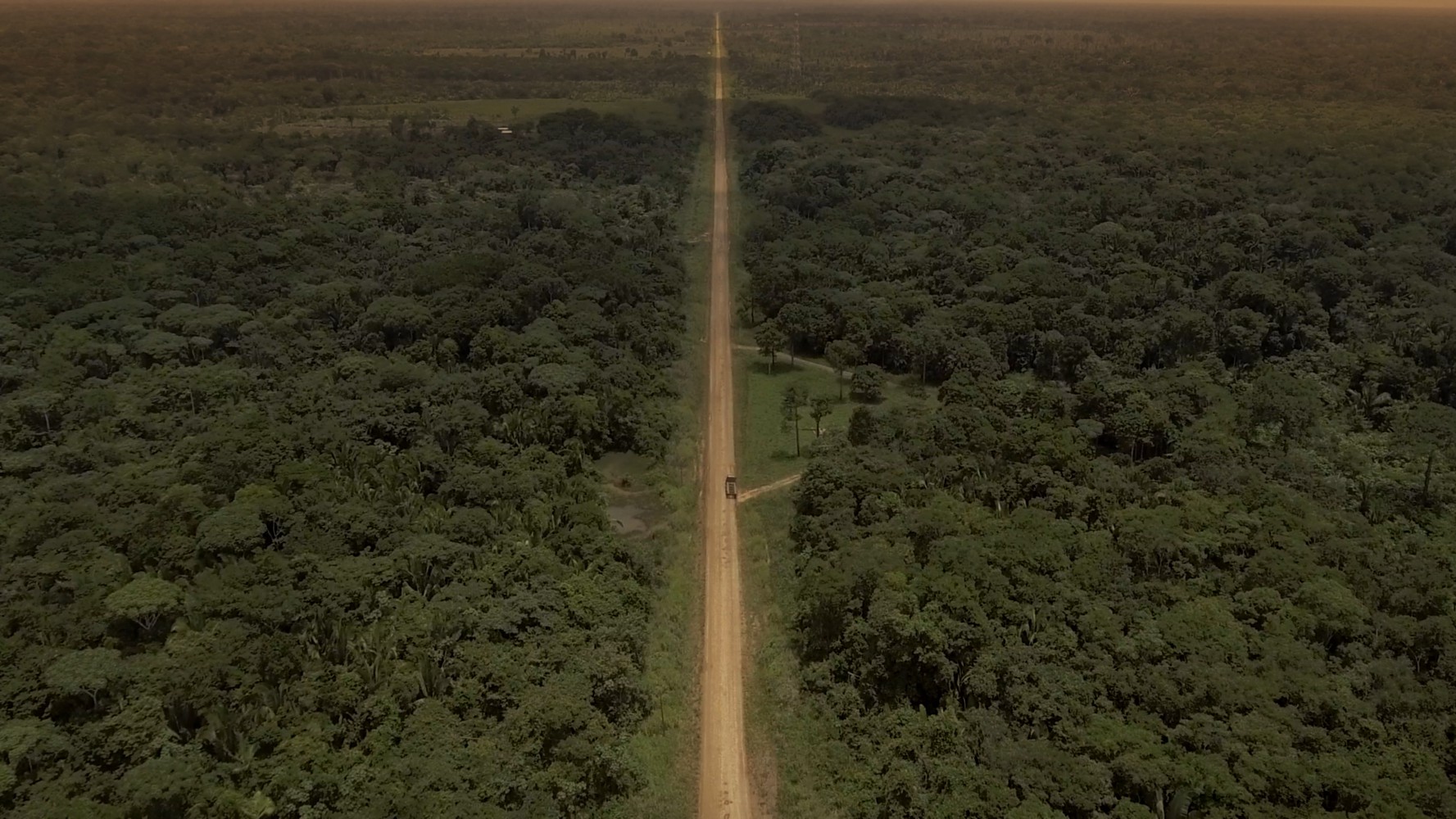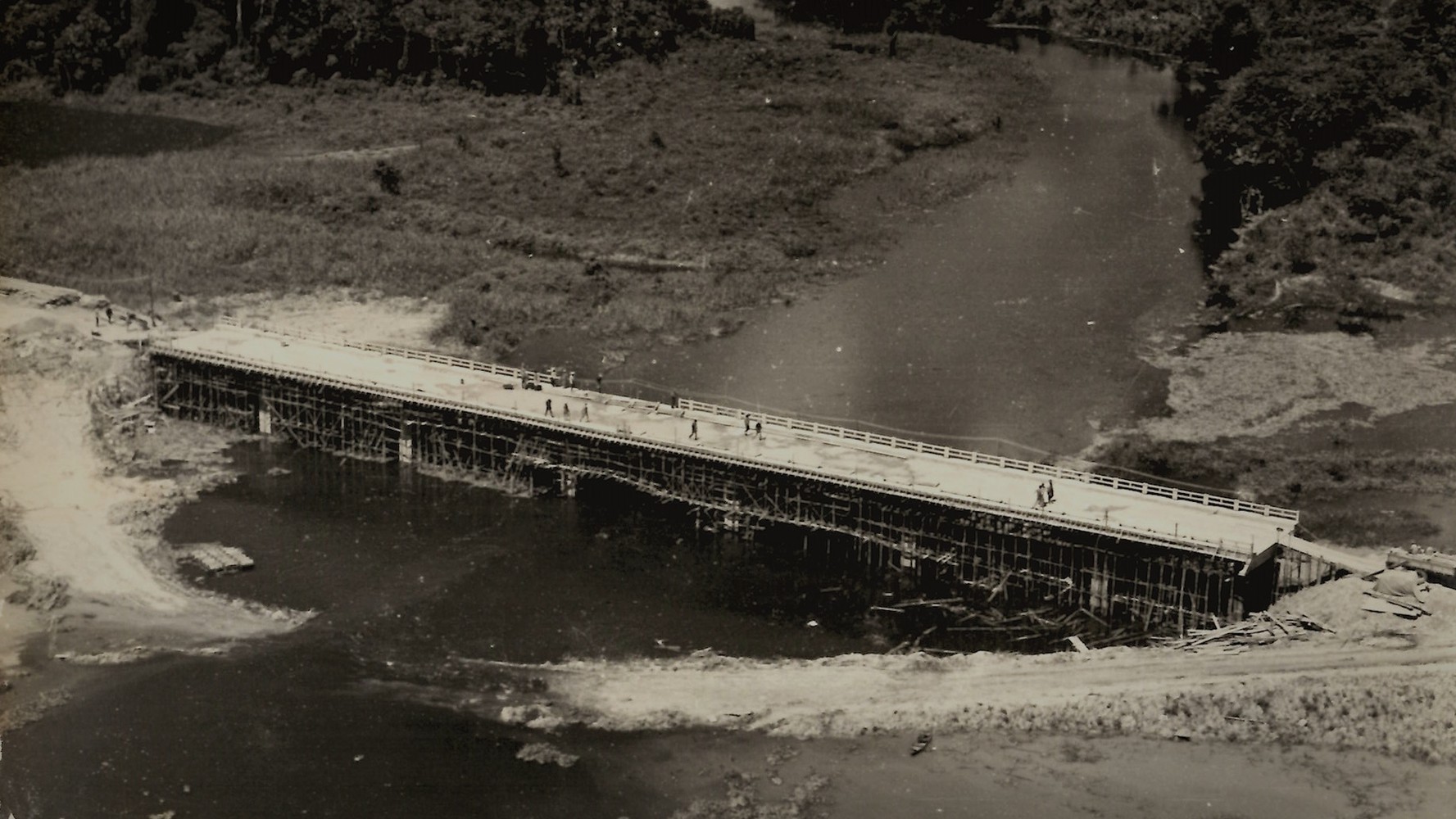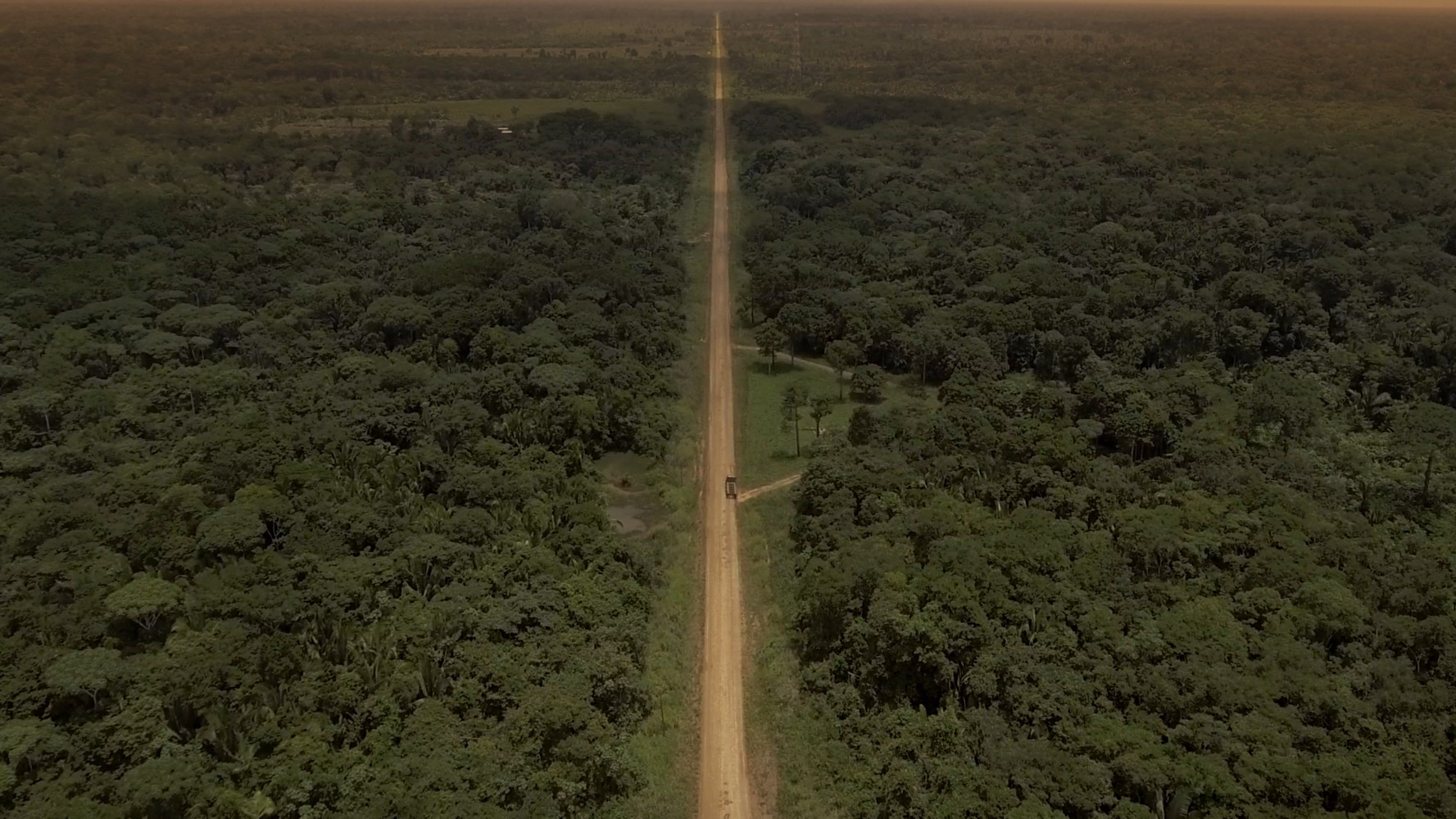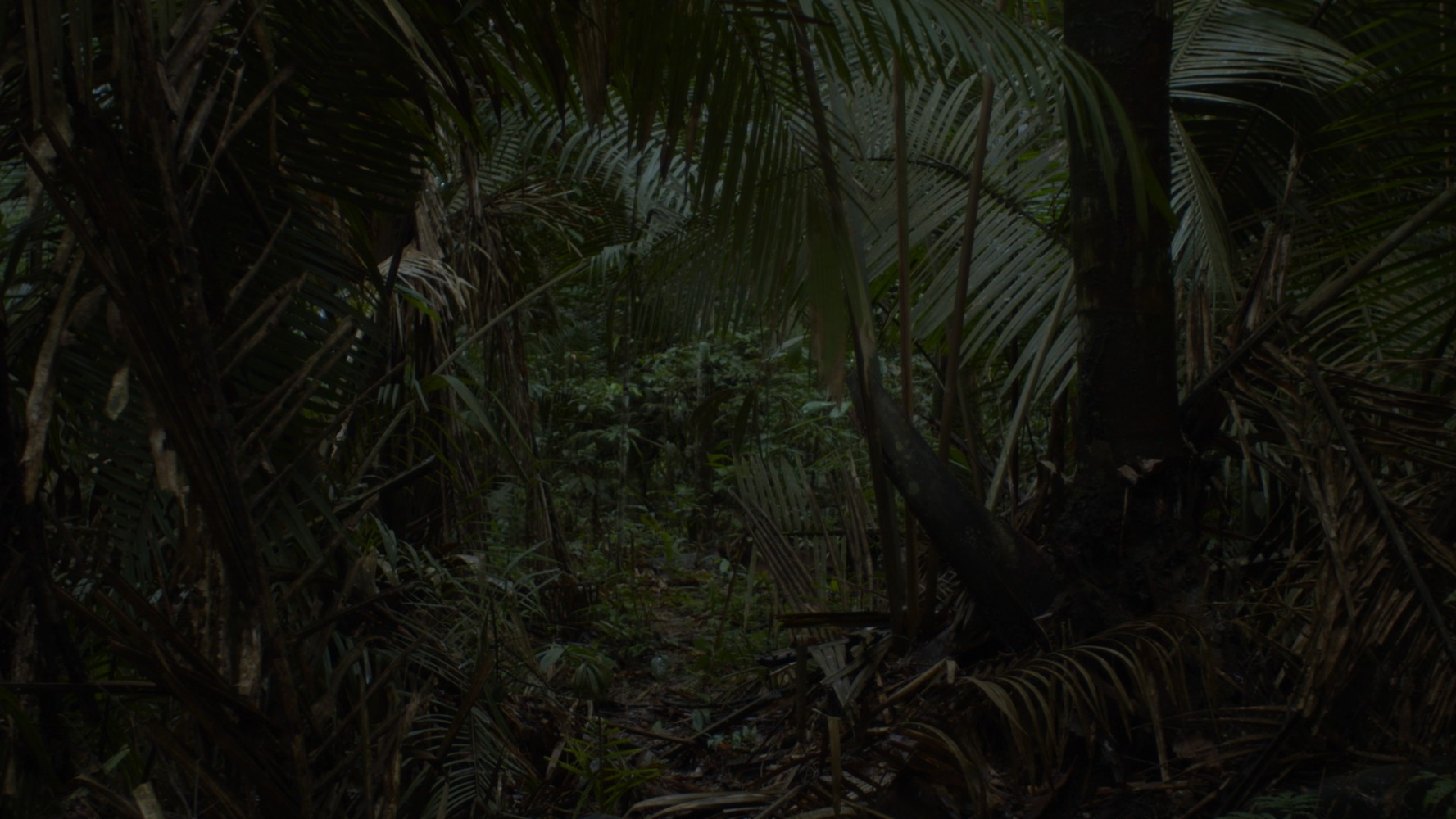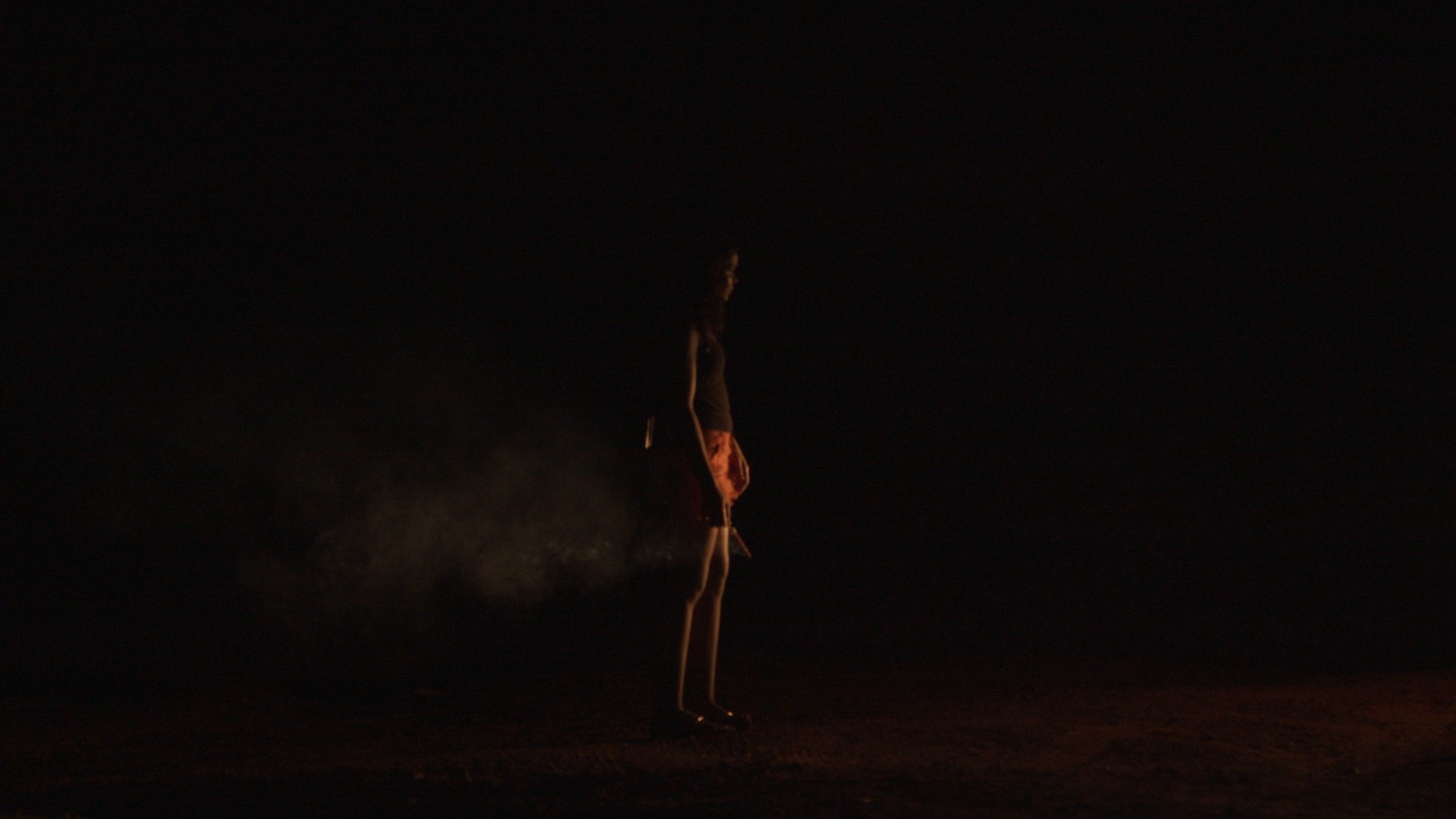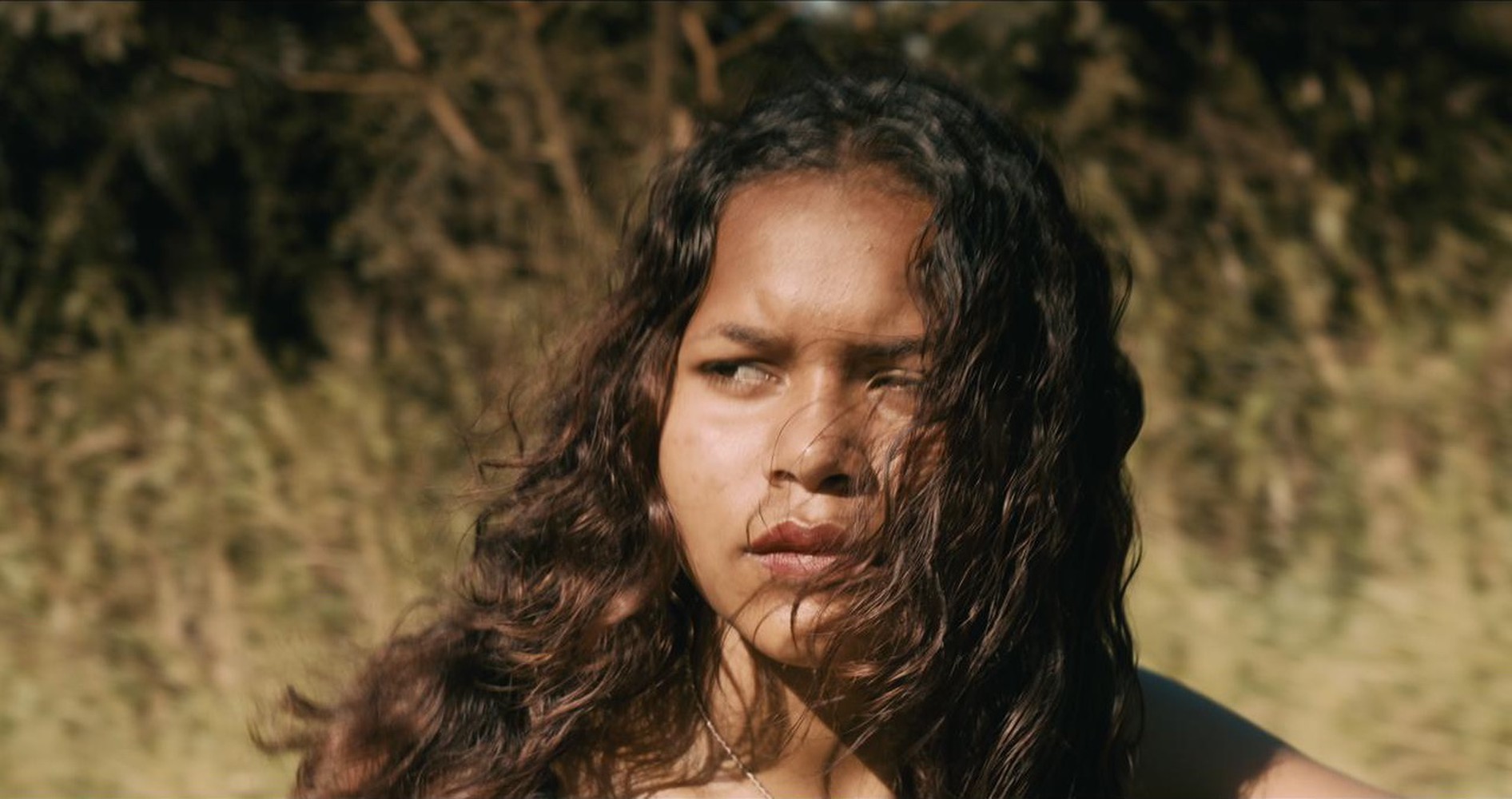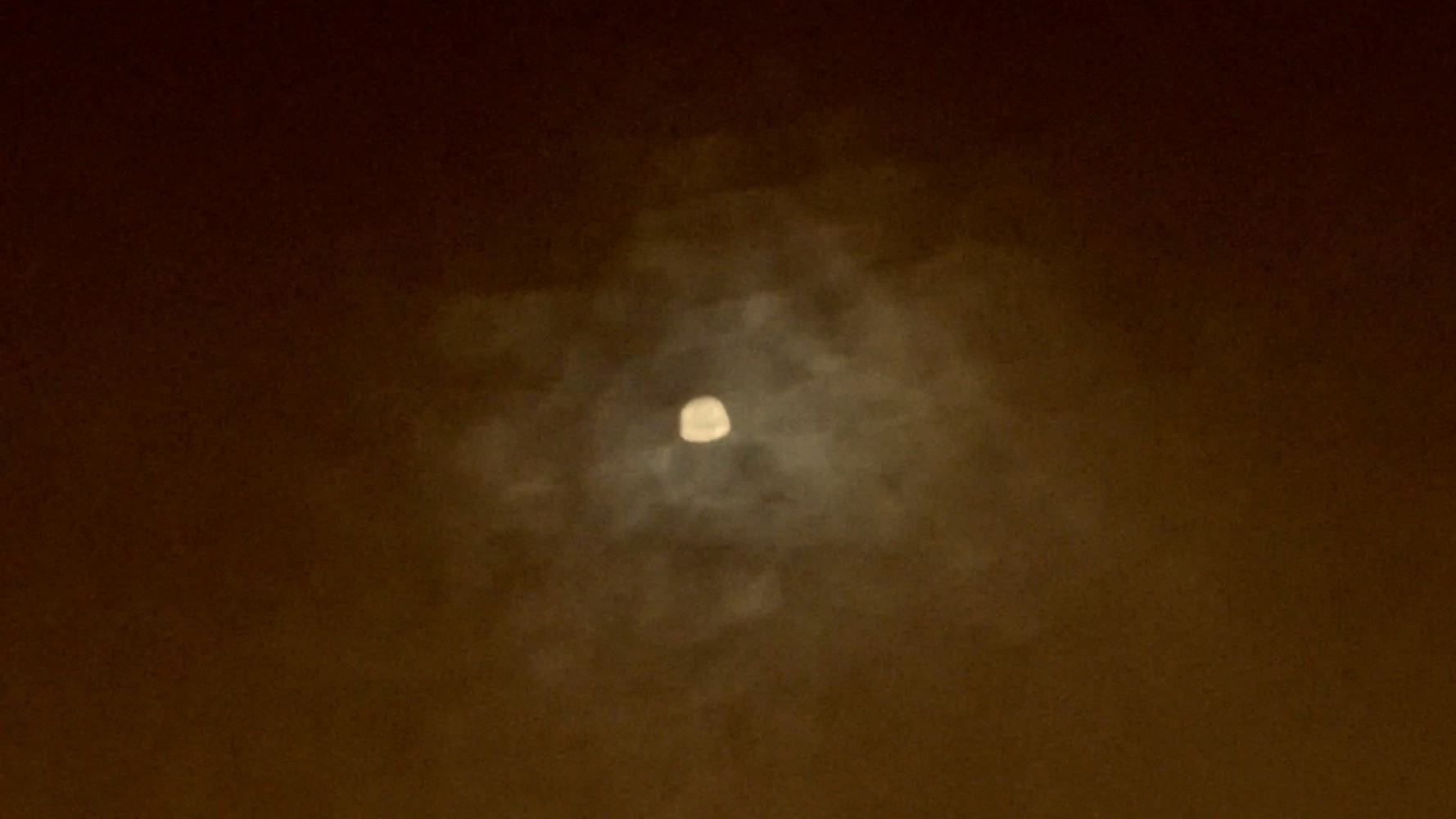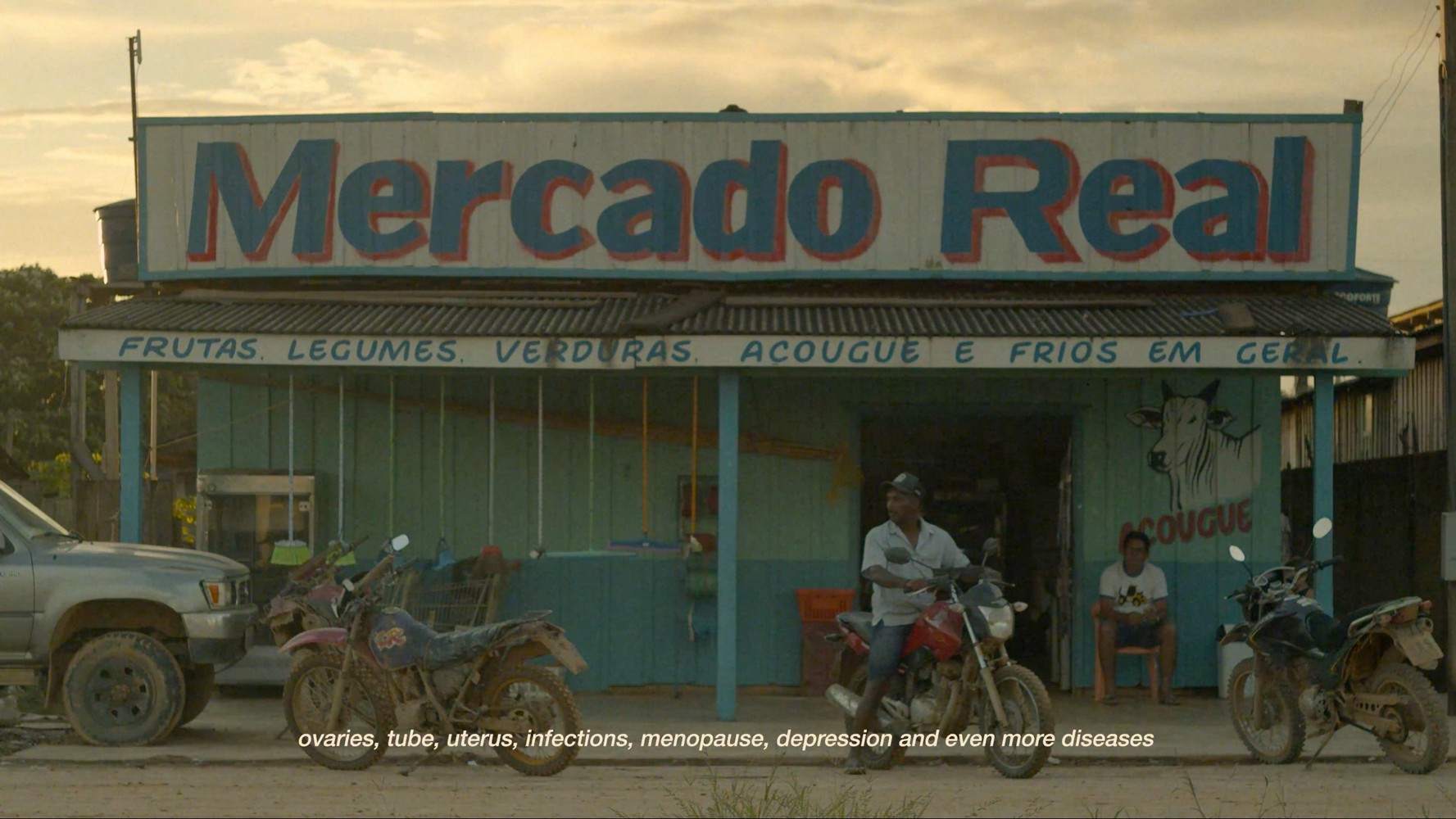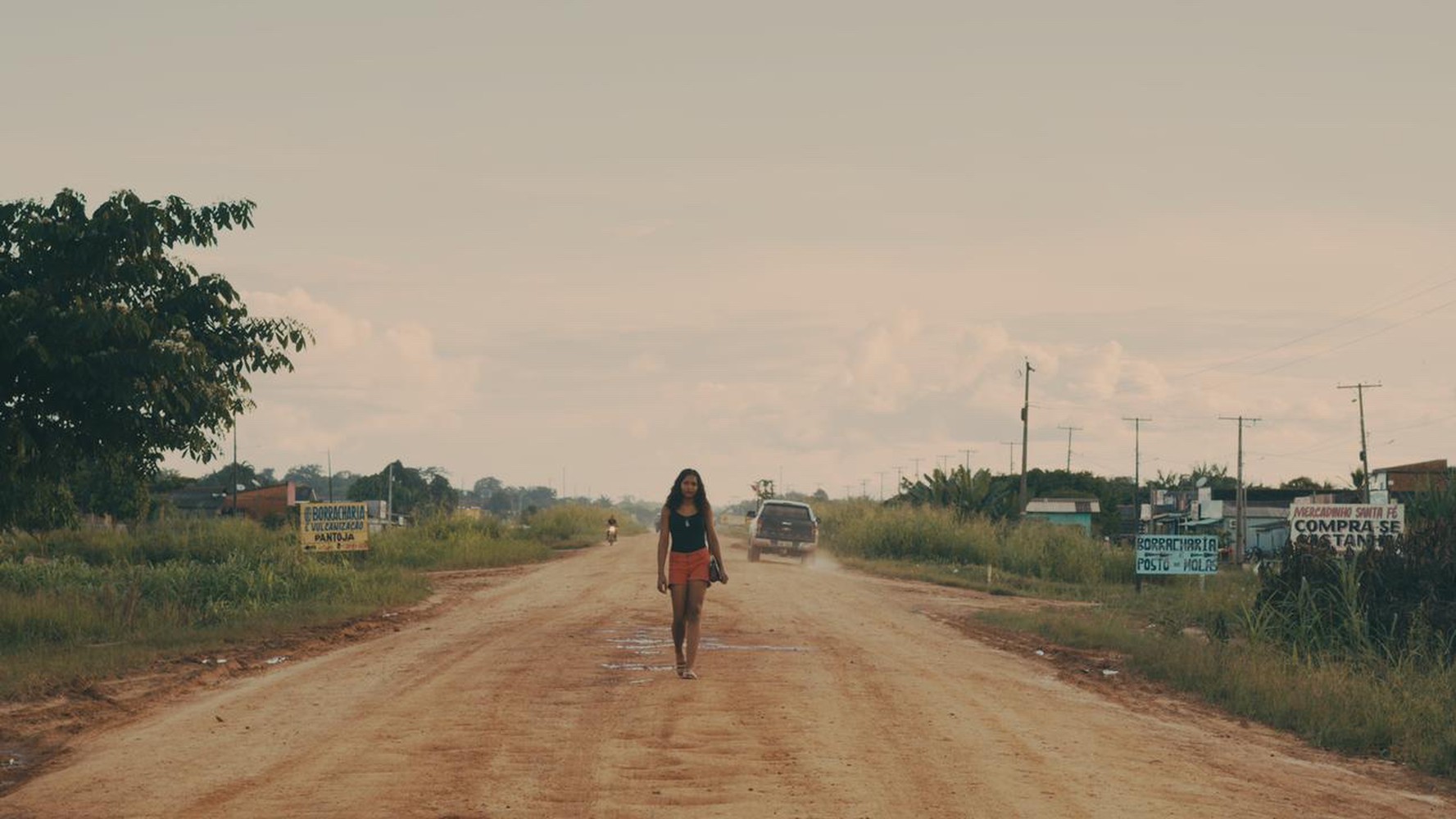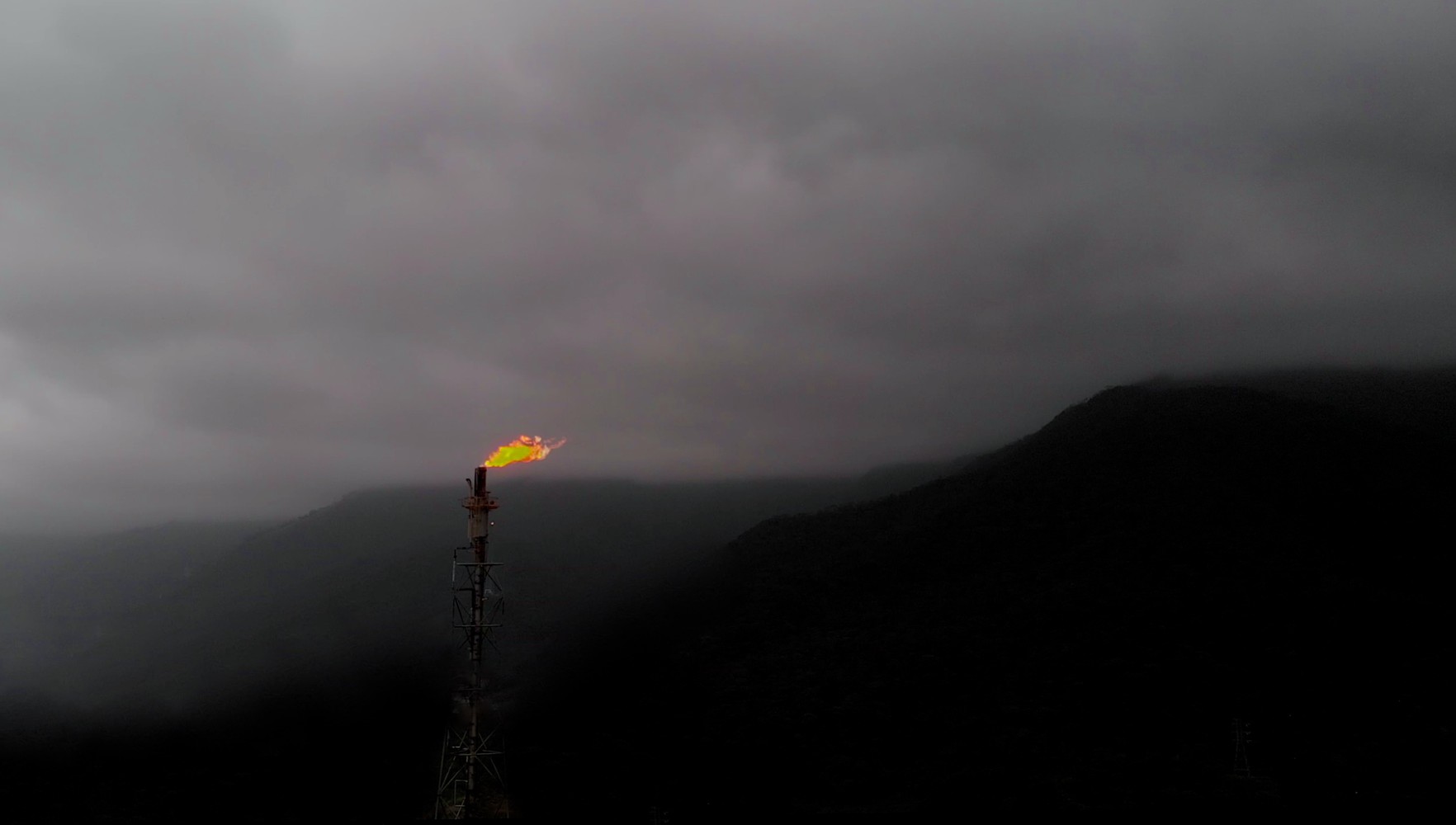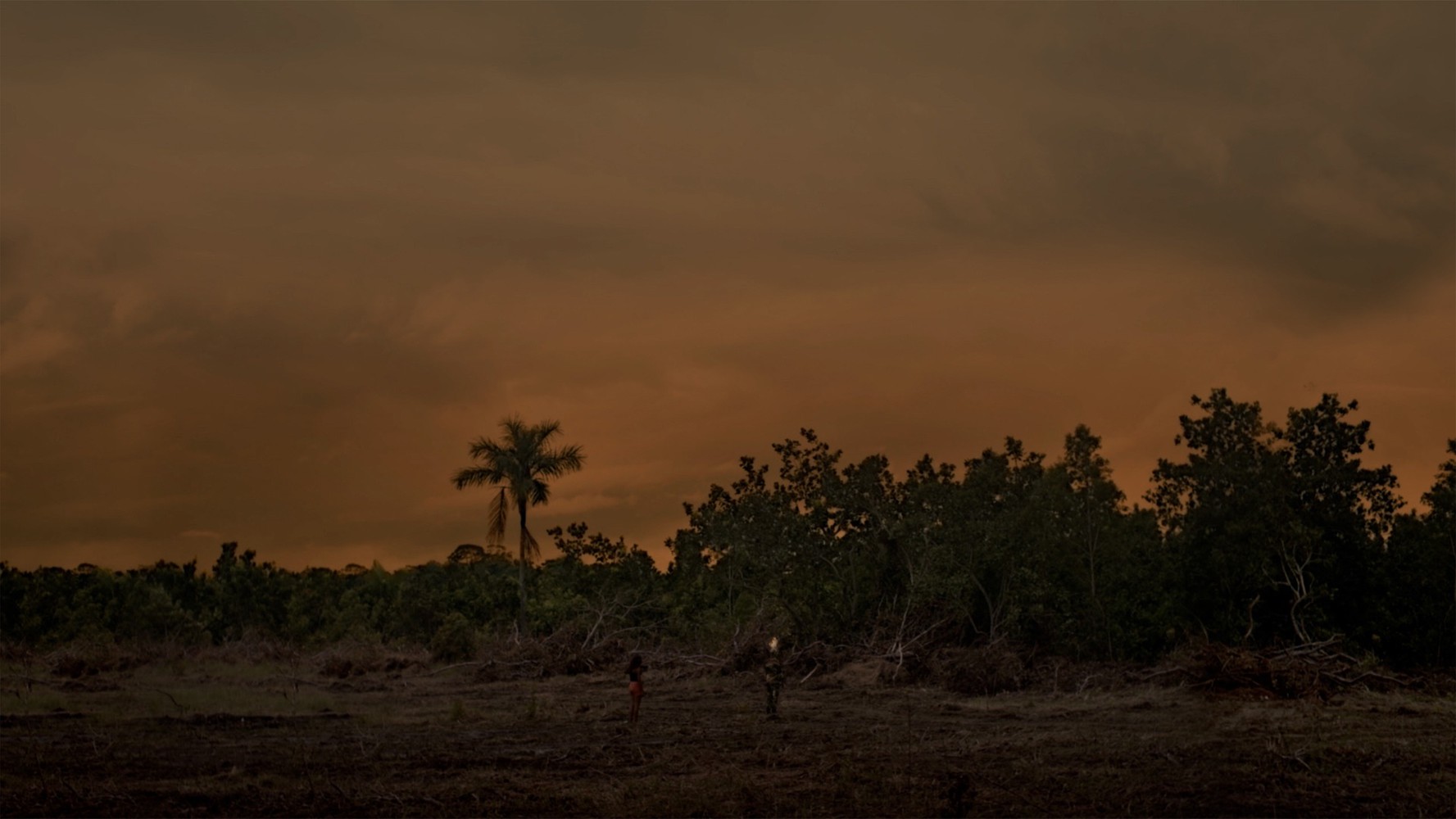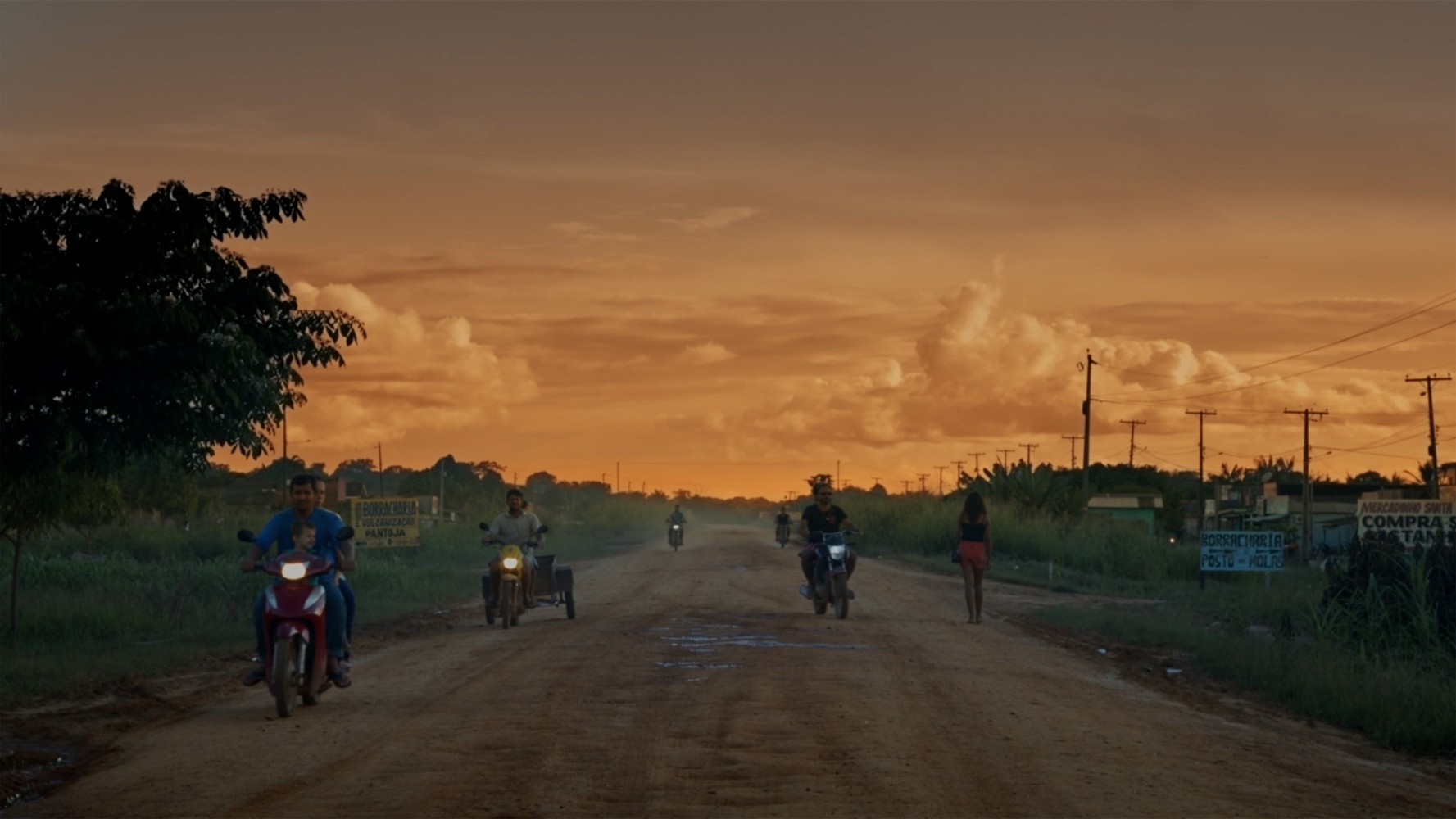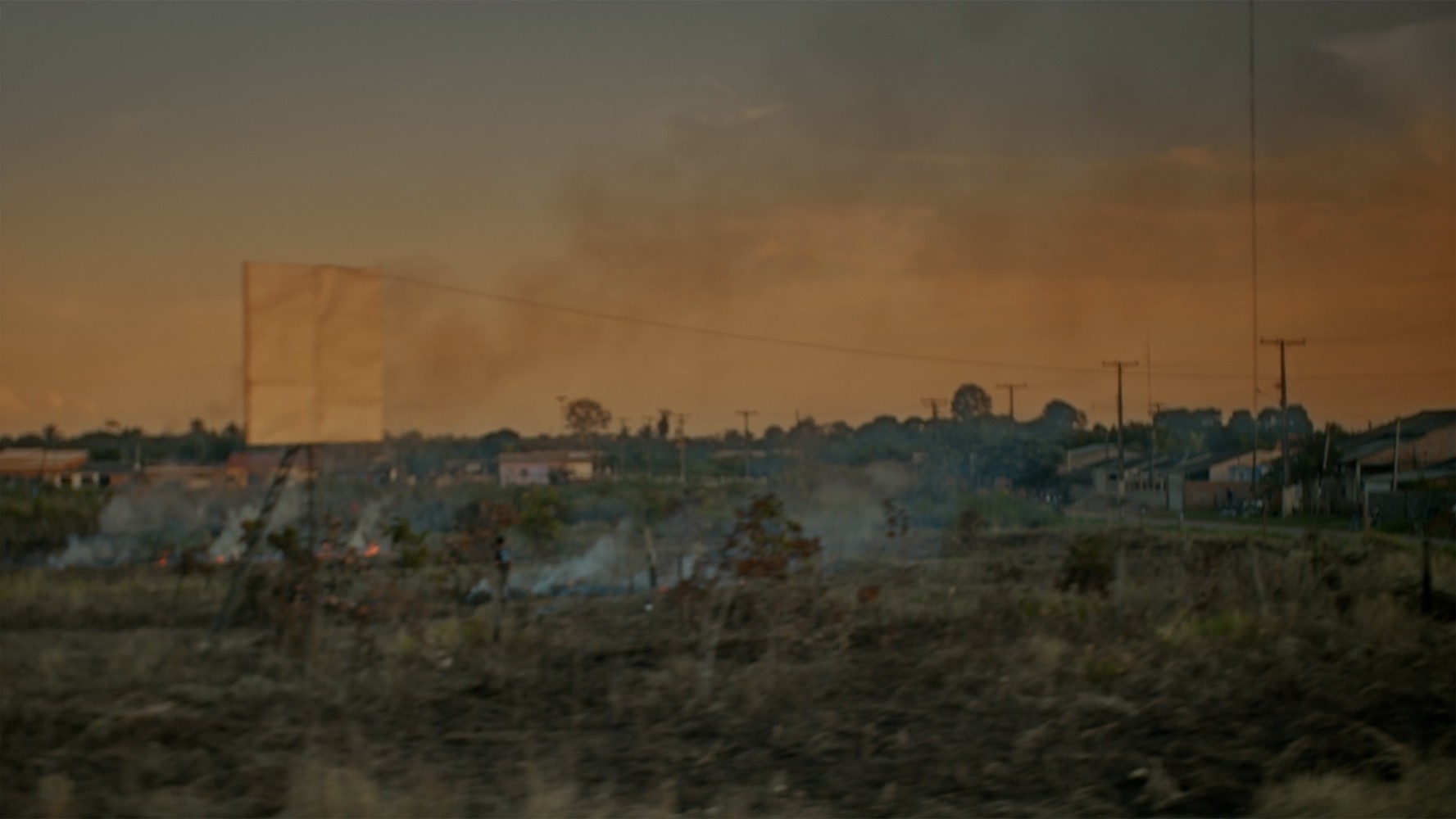Tourné dans le village de Realidade, sur la BR-319, en Amazonie brésilienne, Curupira et la machine du destin est une histoire d’amour et de vengeance entre deux personnages d’époques historiques différentes qui existent à la frontière de la fiction et de la réalité : Curupira et le fantôme d’Iracema. Le film est un extrait de la rencontre dans le temps présent entre l’entité Curupira, un diable queer qui protège les forêts du Brésil, et Iracema, une prostituée cabocla de 14 ans, personnage fictif du film Iracema: Uma Transa Amazônica, réalisé par Jorge Bodanzky et Orlando Senna (1975). Le fantôme d’Iracema tombe amoureux de l’image de Curupira et se lance à sa quête au carrefour des routes droites de l’Amazonie pour matérialiser une prophétie, comme une sorte de mythe de Prométhée à l’envers : enterrer le feu en le ramenant sur terre, évoquer Curupira et venger l’avenir.
Les résidents du Distrito da Realidade, ONG Casa do Rio, ISA – Instituto Socioambiental São Gabriel da Cachoeira, Victória Pereira, Carine Wallauer, Christyann Ritse, Marcela Santos, Carolina Gesser, João Pedro Rodrigues, Anne Creissels et la force du chaos de Curupira.
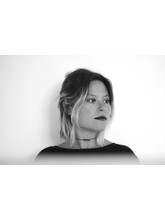
Janaina Wagner est née à São Paulo, Brésil. Plasticienne, journaliste, enseignante en vidéo pour des enfants et titulaire du master SPEAP (Expérimentation en arts et politiques), elle travaille avec divers médias : installations, vidéo, photographie, livres, dessins, scénographie et peinture. À la recherche des points de friction entre l’humain et les constructions qu’il édifie lui-même, elle explore les formes et les sujets qui font référence aux relations de limite, de contrôle et de contention que l’homme établit avec le monde, ainsi qu'à la finitude en soi. Janaina a participé à plusieurs résidences artistiques, telles que FID Campus - Festival International de Cinéma de Marseille (Marseille), Festival Mondes Possibles - Théâtre Nanterre-Amandiers (Paris), Bolsa Pampulha (MG, Brésil), Red Bull Station (SP), Casa Tomada (SP), Anarcademia, (W139, Amsterdam) et NES Skagaströnd, sur la côte rurale de l’Islande.
Diplômée des beaux-arts et en journalisme, titulaire d'un master dans le Programme d’Expérimentation Artistique et Politique (SPEAP) et enseignante en vidéo, les références de Janaina renvoient aux procédures par lesquelles l’humanité inscrit et articule ses progrès et son héritage. Janaina vit et travaille entre Roubaix et São Paulo.
CursusART RESIDENCIES:
2017 Pivô Pesquisa – Pivô (São Paulo, SP – Brazil)
2017 Centre Les Récollets (Paris, France)
2016 RAM – Residência Artística Mutuca (Altamira, MG – Brazil)
2016 Bolsa Pampulha (Belo Horizonte, MG – Brazil)
2015 Red Bull Station (São Paulo, SP – Brazil)
2015 Casa Tomada + Fresh Milk Barbados (São Paulo, SP – Brazil)
2014 Residência Phosphorus 2014 (São Paulo, SP – Brazil)
2013 COMO Clube (São Paulo, SP – Brazil)
2013 Projeto Residência – 12o Festival de Arte Serrinha (Bragança Paulista, SP – Brazil)
2013 NES (Skagastrond, Iceland)
2012 Anarcademia, W139 (Amsterdam, Netherlands)
2011 Projeto Experiência, Itaú Cultural (São Paulo, SP – Brazil)
SOLO SHOWS:
2017 Floresta – Museu do Esquilo (Ibiuna, SP)
2016 Criatura – Oficina Cultural Oswald Andrade (São Paulo, SP – Brazil)
2015 Decupagem/ Crônica de um final anunciado – Museu de Arte de Ribeirão Preto – MARP (Ribeirão Preto, SP – Brazil)
SELECTED GROUP EXHIBITIONS:
2018 Festival Mondes Possibles - Centre dramatique national Nanterre-Amandiers (Paris, France)
2018 14o Festival Hors Pistes - Centre Pompidou (Paris, France)
2017 Ensaio de Tração - Pinacoteca do Estado de São Paulo (São Paulo, Brazil)
2017 Bestiário - Centro Cultural São Paulo - CCSP (São Paulo, Brazil)
2017 Mágica – 13 Festival VERBO de Performance – Galeria Vermelho (São Paulo, Brazil)
2017 Bad Video Art Festival – A3 Gallery (Moscow, Russia)
2016 Mon Cher Magma – Atelier W (Paris, France)
2016 Permanências e Destruições – Torre H (Rio de Janeiro, Brazil)
2015 Galeria Transitória – Red Bull Station (São Paulo, Brazil)
2015 Concrete Matter – Warm (São Paulo, Brazil)
2014 4o Prêmio EDP nas Artes – Instituto Tomie Ohtake (São Paulo, Brazil)
2014 32th Coopy RIghtOTs - 8. Salon (Hamburg, Germany)
2013 4o Prêmio Belvedere de Arte Contemporânea – Galeria Belvedere (Paraty, Brazil)
2013 The New York Art Book Fair – MoMA PS1 (New York, United States of America)
2012 Anarcademia, W139 (Amsterdam, Netherlands)
OTHER FORMATIONS:
2017 - Independent Program of Museu de Arte de São Paulo PIMASP - MASP - One year formation program (São Paulo, Brazil)
2016 Drawing and Cinema – Escola de Comunicações e Artes da Universidade de São Paulo – Special student at the Master program of Visual Poetics - ECA - USP (São Paulo, Brazil)
_2013 Bachelor at Pedagogy in Fine Arts - Faculdade Santa Marcelina - FASM (São Paulo, Brazil)
Production : Le Fresnoy, Studio national des arts contemporains
L’âme et le corps, les frontières, les fractures entre matériel et immatériel, les jeux qui proposent de les abolir... Ici le réel et le virtuel sont ensemble sur un fil funambule. l’empiriste David Hume écrivait : « tous les matériaux de la pensée sont tirés de vos sens, externes et internes, c’est seulement leur mélange et leur composition qui dépendent de l’esprit et de la volonté 1. » Dans Panorama 23, il ne s’agit donc pas du choix d’un idéalisme exalté ou d’un goût prononcé pour une magie des illusions, mais bien plutôt d’une réponse à la réalité du monde par l’expérience. la question est alors d’étayer notre pouvoir créateur sur ce qui nous permet de concevoir cette réponse, sans négliger aucune de ses dimensions, en particulier celle du rêve. Celle-ci ne se contente pas de l’accomplissement physique du vol pourtant si proche des légendes oniriques. Ce signe ascendant, cette élévation, que nous permettent-ils ?
Un avion, un planeur, présents dans une des œuvres, ne sont plus les assemblages d’Icare ou de simples mécaniques, mais des véhicules mentaux, des traductions, d’une nature à l’autre, qui en disent beaucoup sur nos capacités de vivre « ailleurs », au-dessus d’une ligne d’horizon, qui « éclairent » autrement les connexions des synapses de nos vies cérébrales.
Cette énergie transformatrice nous projette au-delà. Débordant l’écosystème entre le ciel et la terre, elle génère la conscience d’un corps, désormais parcelle vivante du cosmos. Ce corps cosmique est solidement attaché aux jours et aux heures de nos vies, entraîné en une déambulation permanente au sein de l’espace, composé des territoires instables de la mémoire et des forces lancées vers je ne sais quelle rive. Si nous ne les maîtrisons pas, c’est parce que nous sommes entre leurs chorégraphies les liant et les déliant. nous appartenons à l’histoire de nos corps mais nous la dépassons sans cesse pour des univers que nous cherchons à habiter ou dans lesquels nous nous projetons sur des écrans visibles ou invisibles. Dans ces films, des êtres humains naissent ou s’éteignent. J’entends à peine leur souffle. leurs yeux sont fermés... ils dorment. Sont-ils plongés au fond d’eux-mêmes, fascinés par les teintes humorales, les circulations sanguines, les secrétions qu’ils sont, en secret, les seuls à voir, comme autant de spectateurs solitaires ? Contemplent-ils leur nature abstraite, leurs territoires internes, leurs ballets colorés, leurs multiplications ou leurs disparitions.
Il faut lâcher, alors, les codes de la réalité pour le réel et ses multiples manifestations à l’écart des lexiques. le corps n’est plus devant nous. Il s’est transformé en une poignée d’obscur, une terra incognita, ou l’arbre, le Tree of life de terence Malick dont nous supposons les lignes qu’il trace, depuis l’entrelacs de ses racines jusqu’au bleu du ciel. Étrange généalogie dont le personnage central est la naissance.
Il y a dans Panorama 23, un rêve qui s’épanouit à partir des inductions de la nature. Elles sont à la fois les acteurs, leurs songes et les scènes qui les accueillent. l’important est, alors, qu’entre les lignes, chaque lapsus, chaque vide, chaque absence, chaque tempête, chaque éclipse, relance le rythme. l’essentiel est la confiance en une continuelle genèse que la musique accompagne, ostinato, spirale sonore qui, s’abandonnant à son propre mouvement, gagne tout l’espace pour nous offrir un lent émerveillement. l’éclosion d’une fleur, d’une écriture, d’une création magnifie cet espace grâce à la surprise et à la beauté de leur croissance. Croissance fascinante du rose, d’une pleine couleur, rose de l’aurore, celui de la chair, rose de Goethe, celui de Guston, ou de Gertrude Stein, « a rose is a rose is a rose is a rose... »
Ce désir, ce plaisir, cette jouissance offrent à notre corps la chance d’être plus grand que soi, animé par le sentiment océanique ou l’infini d’un ciel sans bords, d’un sommet, d’une couleur, sans attribut. Cette couleur peut être le bleu du ciel, de Georges Bataille, de Franck Venaille, le blanc du cosmos ou encore le vert secret d’un brin d’herbe, infime dans l’univers. Ce secret, les artistes nous invitent à le découvrir. Le secret comme source d’émotion et de pensée. Est-il caché dans le tapis, circule-t-il dans les écheveaux de Panorama, le labyrinthe des œuvres ? C’est lui qui donne sa puissance à la création, comme le souligne anne Dufourmantelle : « C’est une force motrice dont on explique mal la créativité. Ses liens avec la mémoire et le langage, notamment dans son rapport au rêve, sont l’objet d’enquêtes et d’expériences qui nous conduisent à repenser l’imagination. (...) le secret qui se révèle dans l’imaginaire n’est jamais une mise à sac ou un arrachement, c’est un monde de lumière et d’ombres où l’on se déplace comme un animal 2, à l’instinct (...) le secret reste le trait qui lie efficacement la vie du désir et la possibilité qu’offre le réel de le recevoir. on suppose donc au réel d’être révélateur d’un désir auquel il offre une possibilité de fixation et de répétition. En reliant divers moments de notre vie, de jour comme de nuit, la vie secrète de nos désirs confère son visage à notre plaisir. n’est-elle pas cette fixation hors parole d’une image ?
Comment dès lors la dévoiler sans mettre en périls, le fragile édifice d’arrêt sur image et donc d’arrêt du temps sur lequel il repose. »les installations, les films de Panorama la dévoilent, en « reliant les divers moments de notre vie de jour comme de nuit ». Ils sont à la recherche d’une image et, dans le même temps, la bouscule, la défont, s’en libèrent pour toucher du doigt une matière non grammaticale et d’autant plus mobile. Je la perçois mais je ne peux la traduire. Plutôt que de la chercher à travers les énoncés, je m’attarde sur les blancs du discours, ses points aveugles, ses effacements, en vérité, une fois de plus, sur son énonciation dont le rythme heurté en dit plus que l’illusion d’une narration. C’est pourquoi dans ce Panorama, les technologies les plus avancées font signe aux techniques rudimentaires, « primaires » ou vernaculaires de l’art brut. C’est là, je crois, que se tient la preuve de la puissance créative du secret. Il nous empêche de dire et permet ainsi de créer en empruntant des chemins de traverse.
À ce sujet, anne Dufourmantelle écrit : « Ce qui fait son pouvoir est aussi d’être au-delà du bien et du mal. Se construisant au tout début du bien et du mal. Se construisant au tout début de notre rapport au langage, il n’est pas étranger à la conscience morale mais il la déborde. Il impose en nous sa valeur d’atout, c’est-à-dire ce qu’il troque, ce qu’il augmente au contact du réel et se déploie dans les interstices du manque, de la frustration, de l’attente, dans les délices du rêve, du premier toucher, des premières sensations, des premières visions.
»Éclipses, égarements, disions-nous, mais aussi présence d’un espace-temps intercalé entre deux mondes, d’un corps hybride, ou encore d’un corps s’échappant comme le corps de loup. Dans ces territoires « écartés », chacun est confronté au vide, aux désordres du vent qui renversent, aux mirages et aux chants des sirènes de l’Odyssée. Plus que sur des routes, ou des parcours balisés, nous sommes « au milieu du carrefour », à la recherche de « ce qui vient ». En art, l’essentiel n’est jamais le programme mais l’archipel des expériences, le pressentiment ou la conscience d’un choix. Certaines œuvres nous rassurent en nous donnant la certitude de « voir », avant que d’éprouver que ce qui est proche s’éloigne, que le sens se voile. la vue qui ainsi s’élève ne saisit plus le motif, se trouble, s’aveugle volontairement, pour retrouver le réel « autrement », non plus en une saisie directe mais dans les dédales du secret que l’on cherche. Désormais, il ne s’agit plus de vue mais de la libération d’une énergie mentale se détachant de l’objet pour mettre en œuvre une approche, polymorphe et sensuelle.
Dès lors, l’art nous permet de « toucher » le cœur, la peau du réel, sachant que l’un et l’autre s’évanouiront dans la nuit des images, où, entre ciel et terre, nous partons, tâtonnant, à leur recherche : le cœur, la peau...
Olivier Kaeppelin
